A Description of the Immigrant Population—2013 Update
Report
May 8, 2013
Letter to the Honorable Paul Ryan
CBO has updated the information in its June 2011 report A Description of the Immigrant Population: An Update. CBO updated 15 of the 20 exhibits contained in that report and added one new exhibit. Those exhibits that could be updated in their entirety have been, and a few others have been updated partially. In some instances, the period covered was altered to focus on the time span since the previous report. CBO’s updated exhibits regarding the immigrant population, along with a list of the agency’s recent reports and selected recent cost estimates for legislation related to immigration, accompany a letter to Congressman Paul Ryan, who requested the update. Five of the updated exhibits are highlighted below with captions describing some of the information they present.
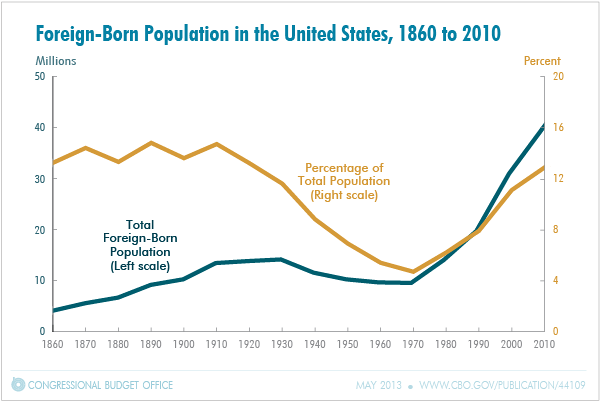
From 1860 to 1910, between 13 percent and 15 percent of people in the United States were born in another country. After 1910, the share of the population composed of the foreign born began a steady decline, falling to less than 5 percent by 1970. But that share has increased rapidly since 1970, reaching about 13 percent in the past few years. About 40 million foreign-born people now live in the United States. Of that group, not quite half have fulfilled the requirements of U.S. citizenship. Of the remaining people, about half are authorized to live and work in the United States, and about half are not authorized to live or work in the country.
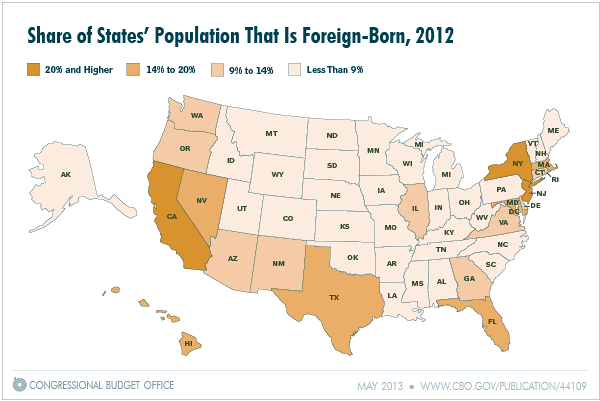
In 2012, three states that account for more than one-fifth of the nation’s population—California, New York, and New Jersey—had a foreign-born population that, for each state, exceeded 20 percent of its total population. In another 17 states, accounting for more than a third of the U.S. population, foreign-born people made up between 9 percent and 20 percent of the state’s total. In the remaining 31 states, accounting for roughly two-fifths of the population—generally, states that are away from the East and West Coasts—the foreign born constituted less than 9 percent.
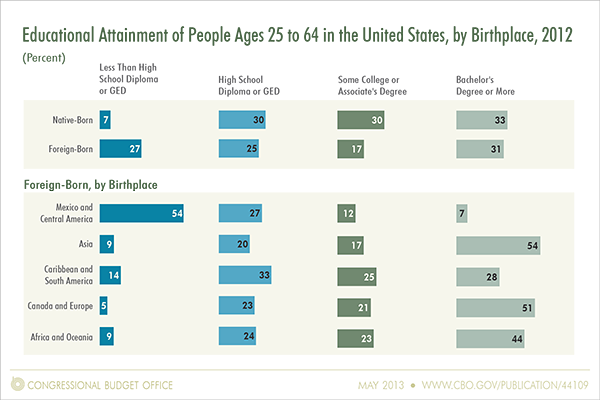
The foreign-born population tends to be less educated than the native-born population: In 2012, 27 percent of the foreign-born population between the ages of 25 and 64 had not completed high school, compared with 7 percent of the native-born population. That difference was even larger among foreign-born people from certain regions of the world: A majority of people from Mexico and Central America, for example, had less than a high school diploma. However, foreign-born people from Asia, Canada and Europe, and Africa and Oceania are more likely than their native-born counterparts to have a bachelor’s degree or more.
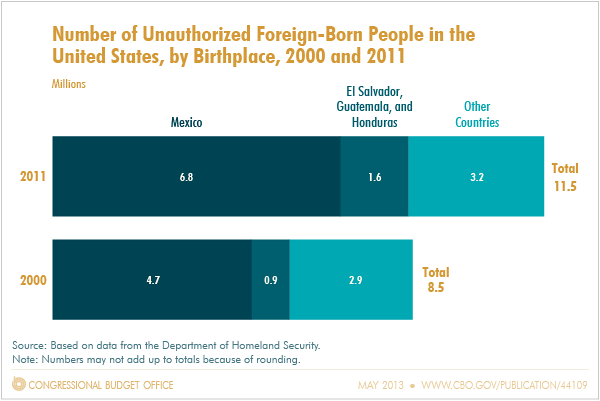
The Department of Homeland Security (DHS) has estimated that, in 2011, about 11.5 million U.S. residents were in the country without legal authorization—about 3 million more than in 2000. Most of that increase was due to an increase in the unauthorized population from Mexico. According to DHS, in 2011 about 6.8 million unauthorized residents in the United States came from Mexico, an increase of more than 2 million since 2000.
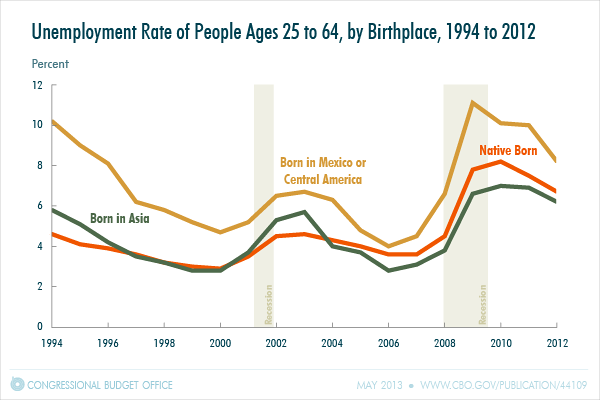
Since 1994, the unemployment rate for foreign-born workers has generally increased when the unemployment rate for native-born workers has increased and decreased when the rate for native-born workers has decreased. However, the unemployment rate for foreign-born workers has fluctuated more widely than the rate for native-born workers, and workers born in Mexico or Central America have faced higher unemployment rates than have their counterparts born in the United States or Asia. On average between 1994 and 2012, the unemployment rate among people born in Mexico or Central America was 7.0 percent, whereas the rate for native-born workers was 4.6 percent and for workers born in Asia, 4.5 percent.
CBO has updated the information in its June 2011 report A Description of the Immigrant Population: An Update. CBO updated 15 of the 20 exhibits contained in that report and added one new exhibit. Those exhibits that could be updated in their entirety have been, and a few others have been updated partially. In some instances, the period covered was altered to focus on the time span since the previous report. CBO’s updated exhibits regarding the immigrant population, along with a list of the agency’s recent reports and selected recent cost estimates for legislation related to immigration, accompany a letter to Congressman Paul Ryan, who requested the update. Five of the updated exhibits are highlighted below with captions describing some of the information they present.

From 1860 to 1910, between 13 percent and 15 percent of people in the United States were born in another country. After 1910, the share of the population composed of the foreign born began a steady decline, falling to less than 5 percent by 1970. But that share has increased rapidly since 1970, reaching about 13 percent in the past few years. About 40 million foreign-born people now live in the United States. Of that group, not quite half have fulfilled the requirements of U.S. citizenship. Of the remaining people, about half are authorized to live and work in the United States, and about half are not authorized to live or work in the country.

In 2012, three states that account for more than one-fifth of the nation’s population—California, New York, and New Jersey—had a foreign-born population that, for each state, exceeded 20 percent of its total population. In another 17 states, accounting for more than a third of the U.S. population, foreign-born people made up between 9 percent and 20 percent of the state’s total. In the remaining 31 states, accounting for roughly two-fifths of the population—generally, states that are away from the East and West Coasts—the foreign born constituted less than 9 percent.

The foreign-born population tends to be less educated than the native-born population: In 2012, 27 percent of the foreign-born population between the ages of 25 and 64 had not completed high school, compared with 7 percent of the native-born population. That difference was even larger among foreign-born people from certain regions of the world: A majority of people from Mexico and Central America, for example, had less than a high school diploma. However, foreign-born people from Asia, Canada and Europe, and Africa and Oceania are more likely than their native-born counterparts to have a bachelor’s degree or more.

The Department of Homeland Security (DHS) has estimated that, in 2011, about 11.5 million U.S. residents were in the country without legal authorization—about 3 million more than in 2000. Most of that increase was due to an increase in the unauthorized population from Mexico. According to DHS, in 2011 about 6.8 million unauthorized residents in the United States came from Mexico, an increase of more than 2 million since 2000.

Since 1994, the unemployment rate for foreign-born workers has generally increased when the unemployment rate for native-born workers has increased and decreased when the rate for native-born workers has decreased. However, the unemployment rate for foreign-born workers has fluctuated more widely than the rate for native-born workers, and workers born in Mexico or Central America have faced higher unemployment rates than have their counterparts born in the United States or Asia. On average between 1994 and 2012, the unemployment rate among people born in Mexico or Central America was 7.0 percent, whereas the rate for native-born workers was 4.6 percent and for workers born in Asia, 4.5 percent.

No comments:
Post a Comment